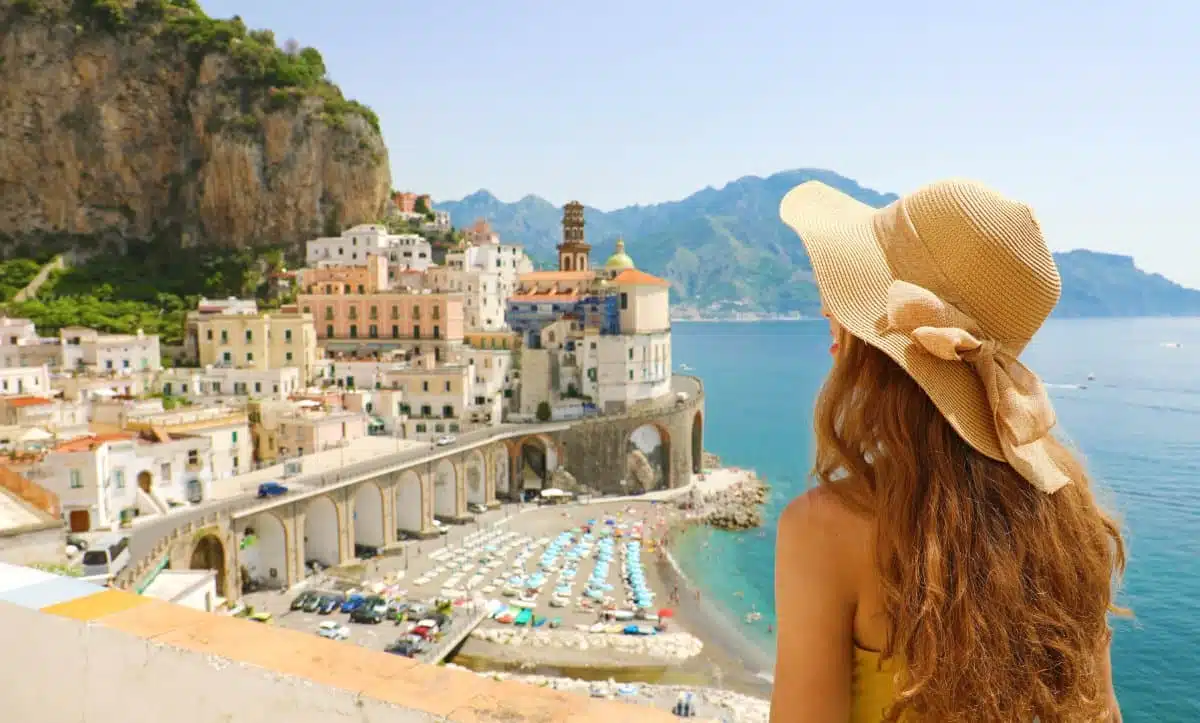The Amalfi Coast, a stretch of coastline on the southern edge of Italy’s Sorrentine Peninsula, is a destination that seems to have been dreamt up from a vivid imagination. With its precipitous cliffs adorned with a palette of colorful villages, lush terraces, and azure waters, this UNESCO World Heritage site offers a blend of breathtaking beauty, rich history, and vibrant culture. From the iconic Positano to the serene Ravello, each town and village along the coast tells its own unique story, inviting travelers to explore, relax, and indulge. This guide highlights must-visit destinations and activities that promise an unforgettable journey through one of Italy’s most cherished landscapes. Whether you’re wandering through ancient streets, savoring the local cuisine, or basking in the Mediterranean sun, the Amalfi Coastline is a testament to the allure of the Italian Riviera.
1. Positano

Image Credit: Shutterstock / Serenity-H
Positano, often considered the jewel of the Amalfi Coast, cascades down the cliffs in a kaleidoscope of pastel-colored buildings. This picturesque village is famed for its pebble beachfront, chic boutiques, and winding streets filled with the scent of lemon and bougainvillea. With its majestic dome, the Church of Santa Maria Assunta stands as a beacon within the village, housing precious artworks and offering a glimpse into Positano’s spiritual heritage. The Path of the Gods, a hiking trail that begins in Positano, offers panoramic views of the coast and the Tyrrhenian Sea, leading adventurers through the rugged landscape that defines this region.
Insider’s Tip: For a unique perspective of Positano, rent a kayak and paddle along the coastline at sunset, when the village is bathed in golden light.
When to Travel: The best time to visit Positano is from April to June, when the weather is warm and the crowds are small.
How to Get There: Positano is accessible by SITA bus from Sorrento or by ferry from Naples, Capri, and other points along the coast.
2. Amalfi
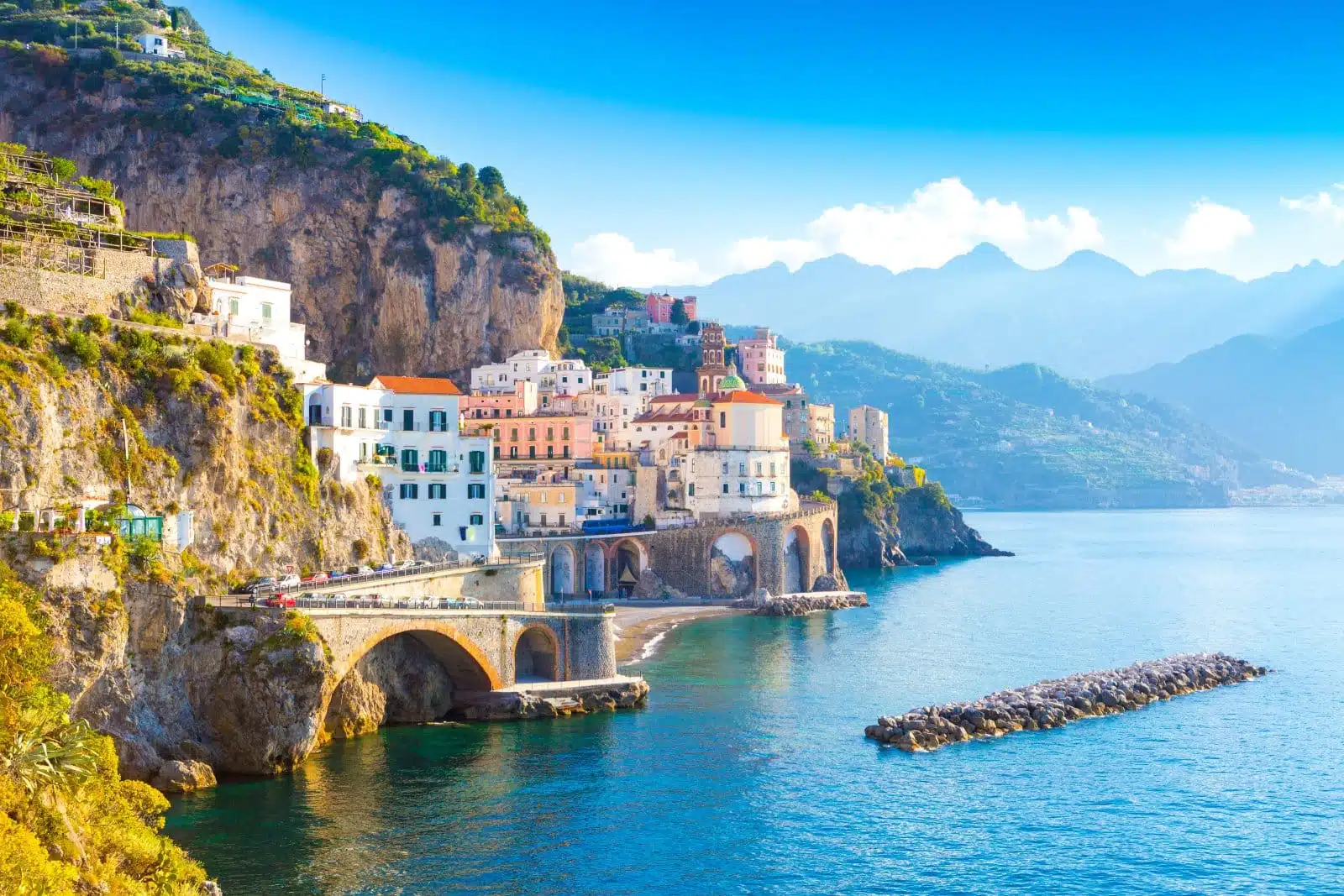
Image Credit: Shutterstock / proslgn
The town of Amalfi, once a powerful maritime republic, is a maze of narrow lanes and alleyways that lead to the impressive Amalfi Cathedral. With its striking façade and intricate bronze doors, the cathedral highlights the town’s rich history and architecture. The Paper Mill Museum offers insights into one of Amalfi’s historic industries, while the nearby Valle delle Ferriere provides a lush escape into nature, with waterfalls and rare plants. Amalfi’s waterfront is a lively hub of activity where visitors can enjoy fresh seafood and observe the comings and goings of daily life along the coast.
Insider’s Tip: Visit the town in the early morning to explore its landmarks before the day-trippers arrive, and the streets become crowded.
When to Travel: Late spring (April to June) and early autumn (September to October) are ideal, offering pleasant weather and thinner crowds.
How to Get There: Amalfi is well-connected by SITA buses from Sorrento and Salerno. During the summer, ferries also run to Amalfi from Naples, Positano, and other coastal towns.
3. Ravello
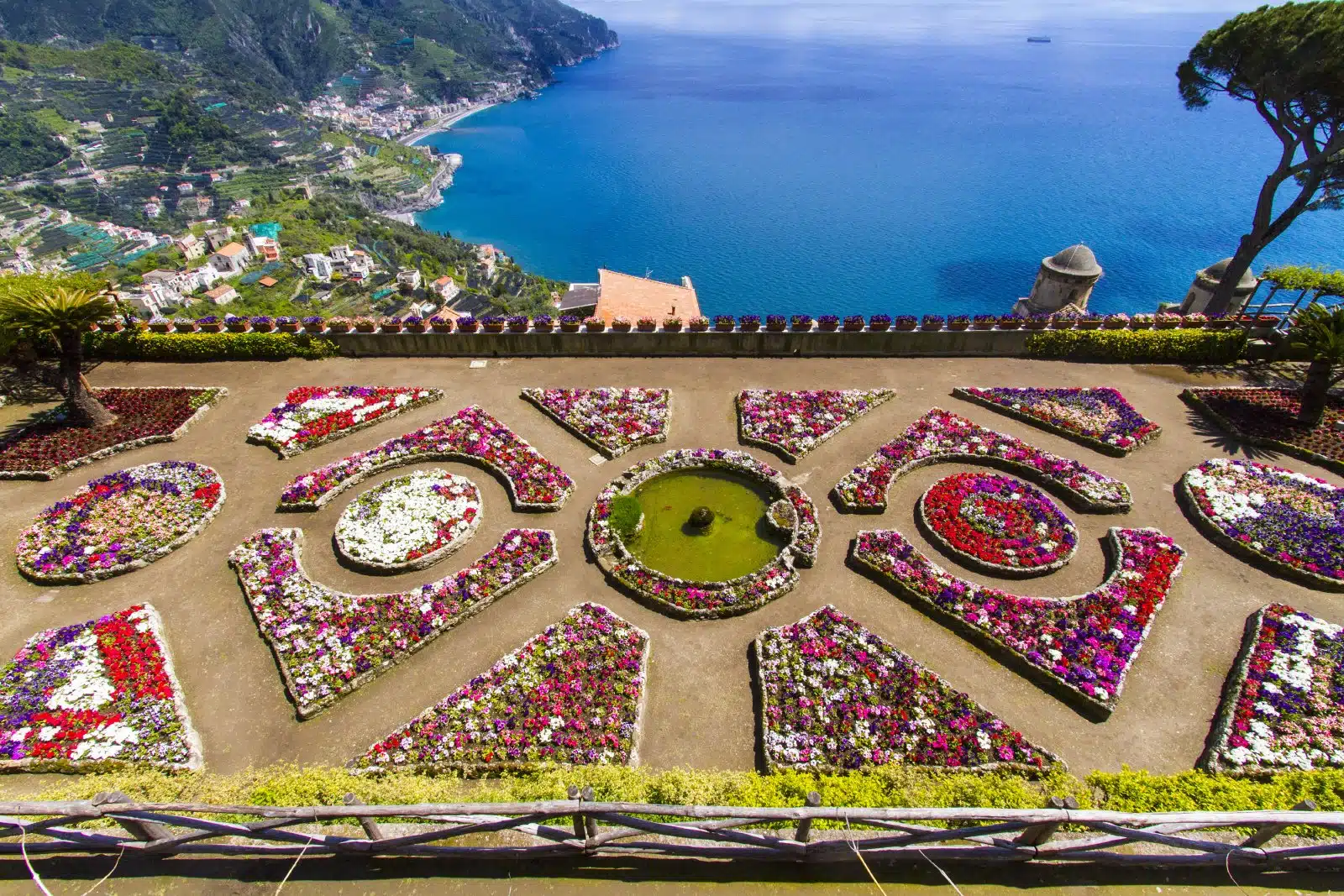
Image Credit: Shutterstock / atm2003
Perched high above the Amalfi Coast, Ravello offers a tranquil retreat from the bustling seaside towns below. Known for its stunning villas, lush gardens, and breathtaking views, Ravello has long been a haven for artists, musicians, and writers. The Villa Rufolo, with its beautiful gardens and panoramic terraces, hosts the Ravello Festival each summer, filling the town with music and cultural events. The Villa Cimbrone, another architectural gem, is famed for its “Terrace of the Infinite,” which offers one of the most iconic views of the Mediterranean.
Insider’s Tip: Attend a concert at the Ravello Festival, where classical music performances are held in the gardens of Villa Rufolo, against a backdrop of sea and sky.
When to Travel: The best time to visit Ravello is during the spring and early summer months, from April to June, when the gardens are in full bloom and the Ravello Festival begins.
How to Get There: Ravello can be reached by SITA bus from Amalfi. The journey up the mountain offers stunning views of the coastline.
4. Capri
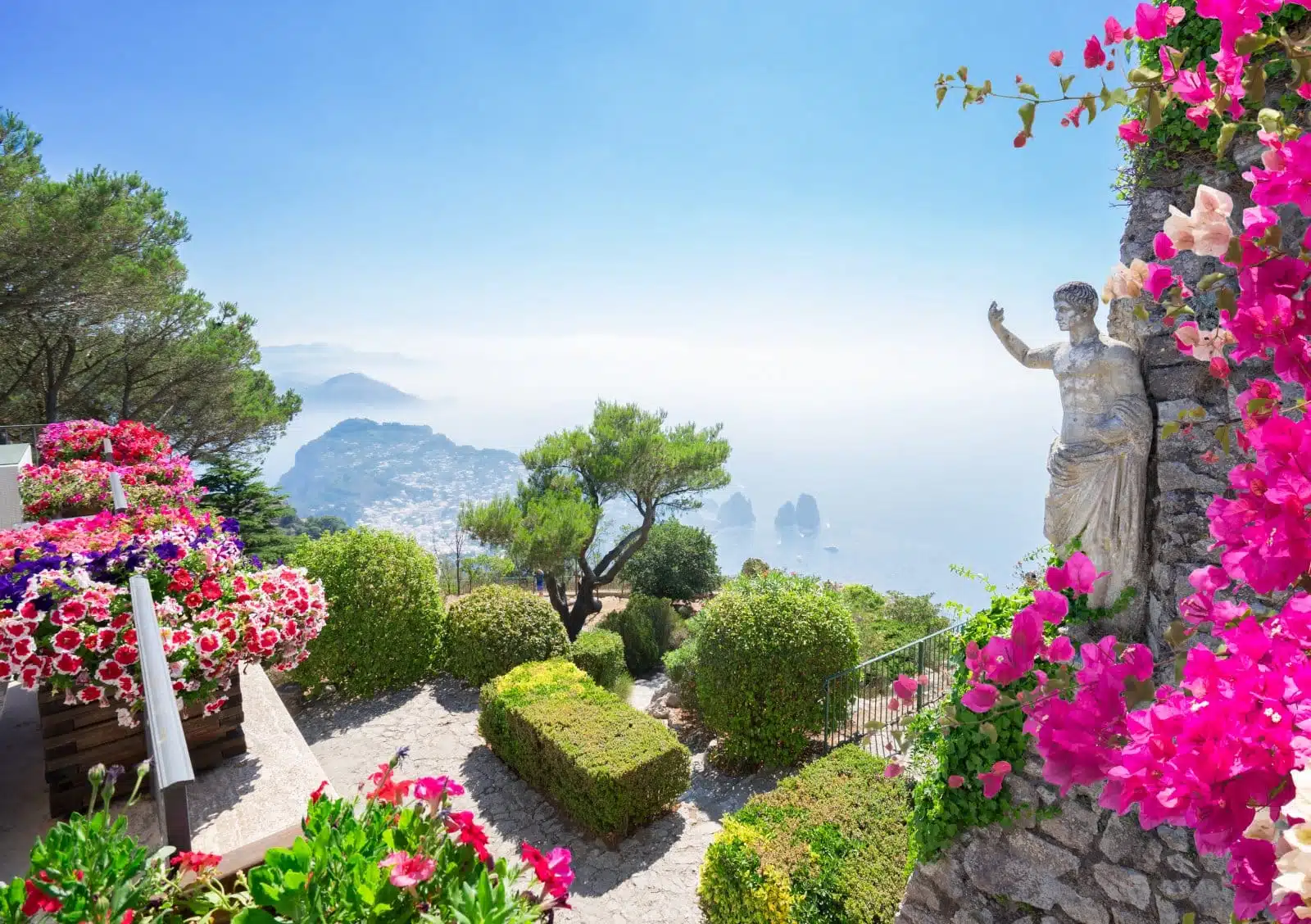
Though not on the Amalfi Coast, the island of Capri is a quintessential part of the experience, just a short ferry ride from the mainland. This enchanting island is known for its dramatic cliffs, hidden coves, and the luminous Blue Grotto. The Piazzetta, Capri’s bustling square, is the heart of island life, surrounded by cafes and designer boutiques. The Gardens of Augustus offer panoramic views of the Faraglioni rocks and the serpentine Via Krupp. For those seeking a more secluded experience, the island’s hiking trails lead to quiet, unspoiled corners of Capri, revealing the natural beauty that has captivated visitors for centuries.
Insider’s Tip: Take the chairlift from Anacapri to the summit of Monte Solaro for breathtaking views of the island and the Bay of Naples.
When to Travel: May and September are ideal, offering beautiful weather without the peak summer crowds.
How to Get There: Ferries to Capri depart from Naples, Sorrento, and Positano. Once on the island, public buses and taxis are available to get around.
5. The Path of the Gods
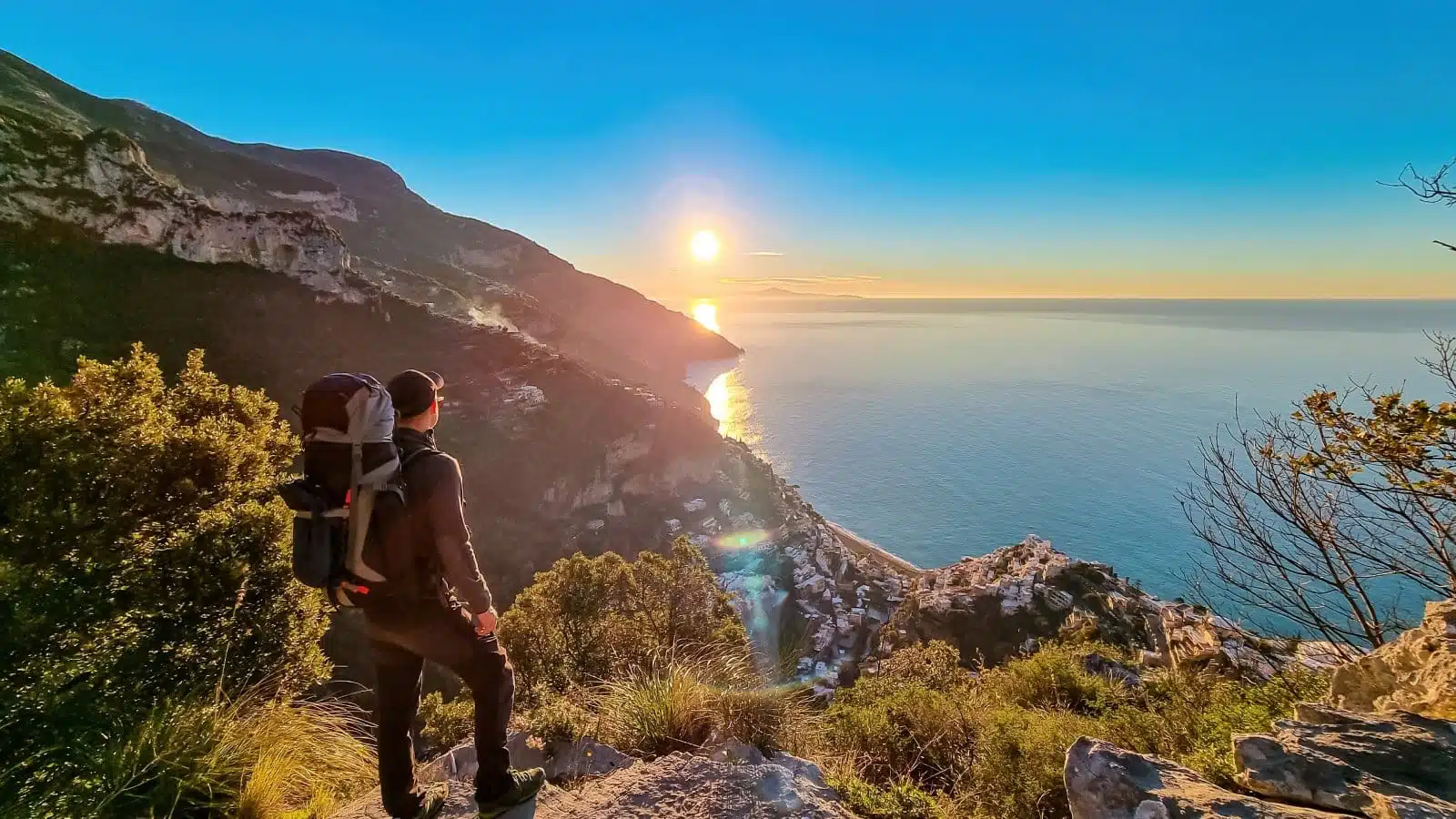
Image Credit: Shutterstock / Christopher Moswitzer
The Path of the Gods (Sentiero degli Dei) is a hiking trail that offers some of the most spectacular views of the Amalfi Coast. Stretching from Bomerano (a fraction of Agerola) to Nocelle (a fraction of Positano), this moderately challenging hike traverses the cliffs high above the Tyrrhenian Sea, through terraced vineyards, ancient stone farmhouses, and aromatic Mediterranean scrub. The path provides a unique perspective on the coast, showcasing its rugged beauty and the vast expanse of the sea beyond. Hikers are rewarded with panoramic vistas stretching into infinity, earning the trail its divine name.
Insider’s Tip: Start the hike early in the morning to avoid the midday heat and to experience the trail at its most peaceful.
When to Travel: Spring (April to June) and fall (September to October) are the best times to hike the Path of the Gods, offering mild temperatures and clear skies.
How to Get There: The trailhead in Bomerano is accessible by bus from Amalfi. From Nocelle, hikers can take a local bus or walk down to Positano.
6. Sorrento
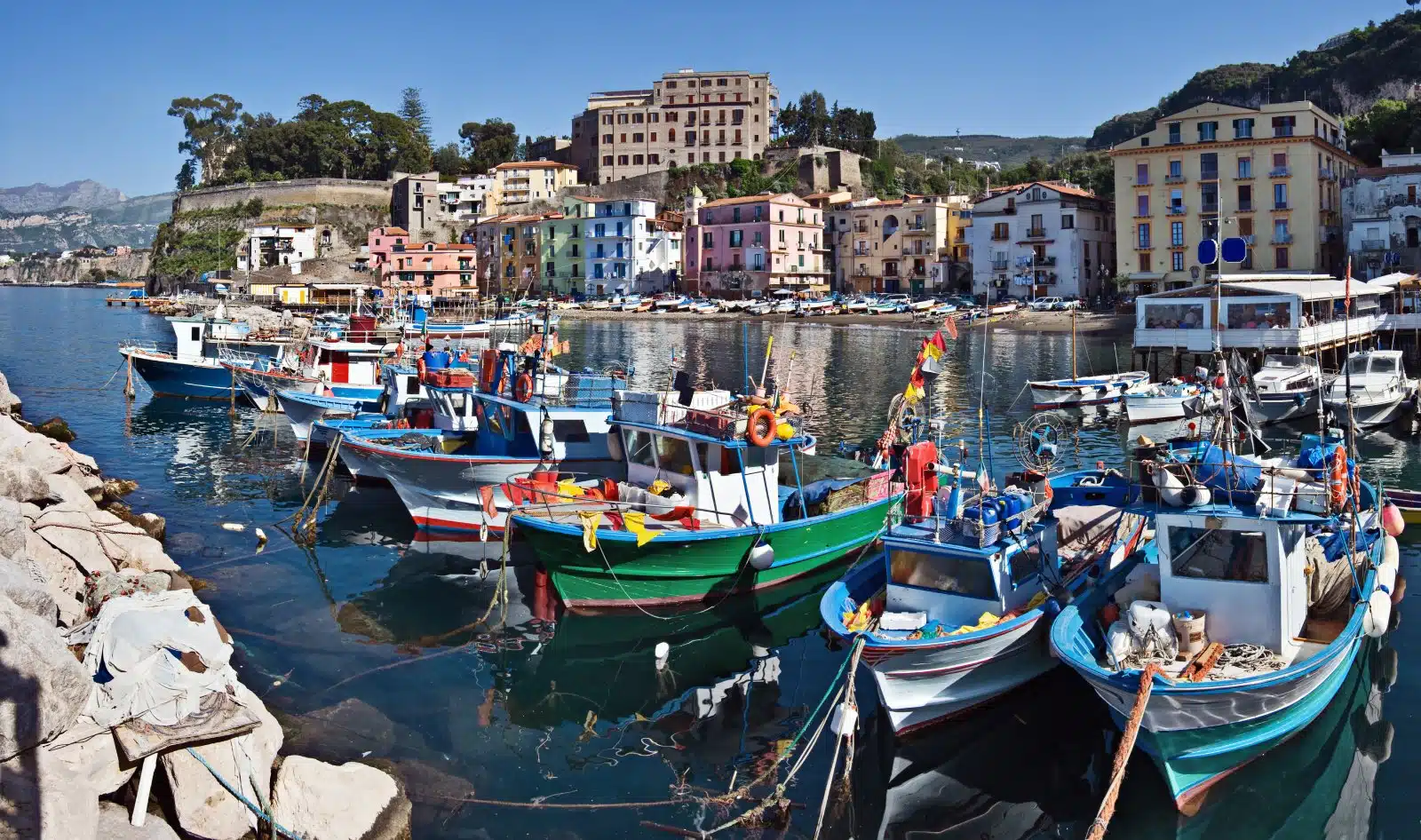
Image Credit: Shutterstock / Khirman Vladimir
Sorrento, perched atop cliffs that separate the town from its bustling marinas, is often considered the gateway to the Amalfi Coast. Known for its sweeping water views, vibrant shopping streets, and the production of limoncello, Sorrento exudes a charm that blends the traditional with the cosmopolitan. The town’s historic center, with its narrow alleys and quaint piazzas, invites leisurely exploration, while the Marina Grande offers a glimpse into Sorrento’s maritime heritage. From Sorrento, visitors can easily access the rest of the Amalfi Coast and nearby Pompeii and Herculaneum, making it an ideal base for exploring the region’s diverse attractions.
Insider’s Tip: Visit an in-town limoncello factory to learn about Sorrento’s famous liqueur production and enjoy a tasting session.
When to Travel: The shoulder seasons of spring (April to June) and autumn (September to October) provide pleasant weather and fewer crowds, making it an ideal time to explore Sorrento and its surroundings.
How to Get There: Sorrento is accessible by train from Naples via the Circumvesuviana railway line. Ferries from Naples, Capri, and other points along the coast also dock at Sorrento’s marinas.
7. Pompeii and Herculaneum
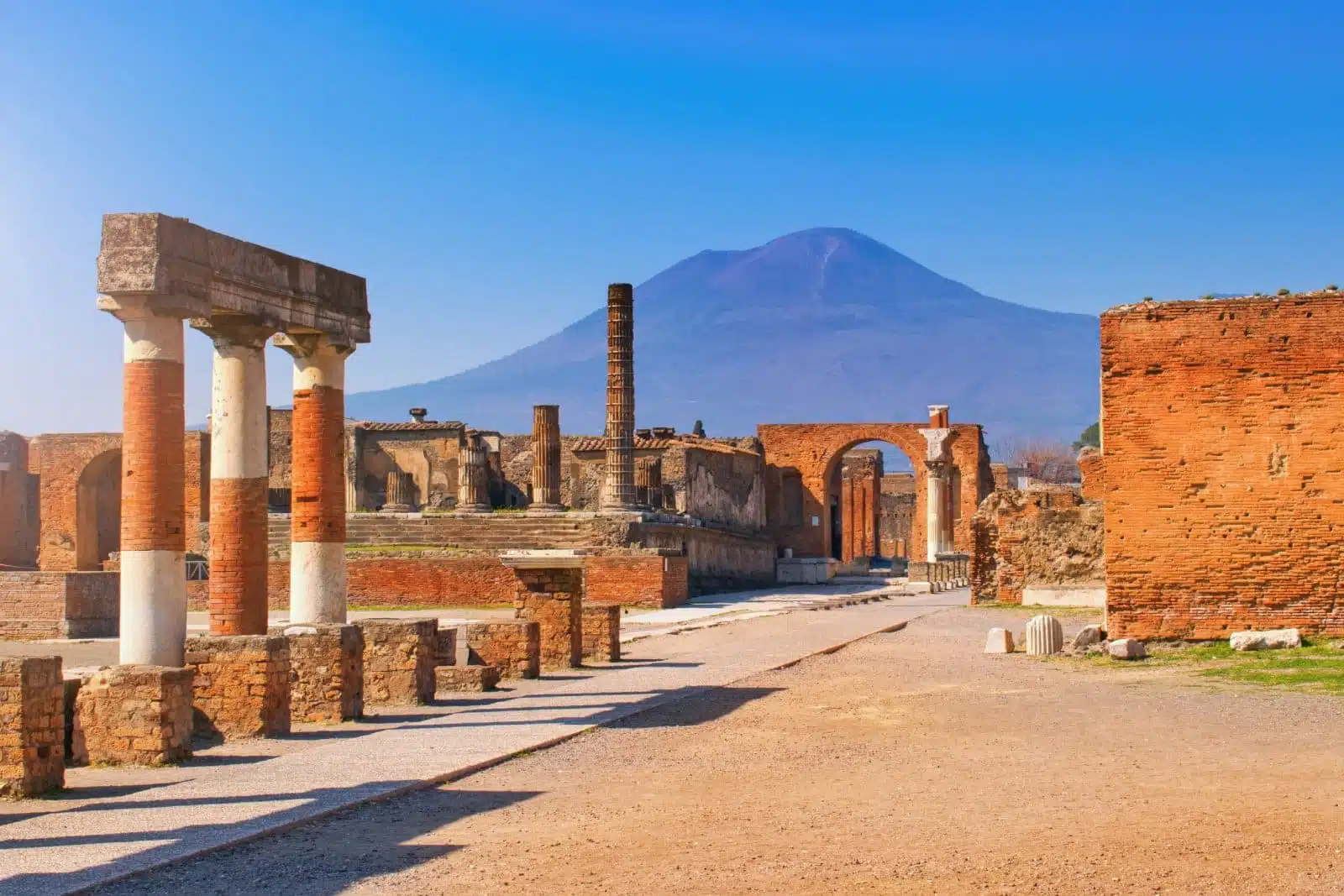
Image Credit: Shutterstock / Tunatura
The ancient cities of Pompeii and Herculaneum, buried by the eruption of Mount Vesuvius in AD 79, offer a fascinating glimpse into Roman life. Pompeii’s sprawling ruins include intact streets, homes, and public buildings frozen in time by volcanic ash. Herculaneum, though smaller, provides a more intimate look at the disaster, with well-preserved wooden structures and stunning frescoes. Both sites are invaluable to historians and archaeologists, offering insights into the ancient Romans’ daily lives, culture, and architecture. A visit to these cities is a poignant reminder of nature’s power and the fragility of civilization.
Insider’s Tip: Purchase a combined ticket to explore both sites over two days, allowing ample time to fully appreciate their scale and significance.
When to Travel: Spring and fall offer milder temperatures for exploring the extensive outdoor sites of Pompeii and Herculaneum.
How to Get There: Both Pompeii and Herculaneum are accessible via the Circumvesuviana train from Naples or Sorrento. Pompeii can also be reached by train from Rome, making it a feasible day trip.
8. The Fiordo di Furore
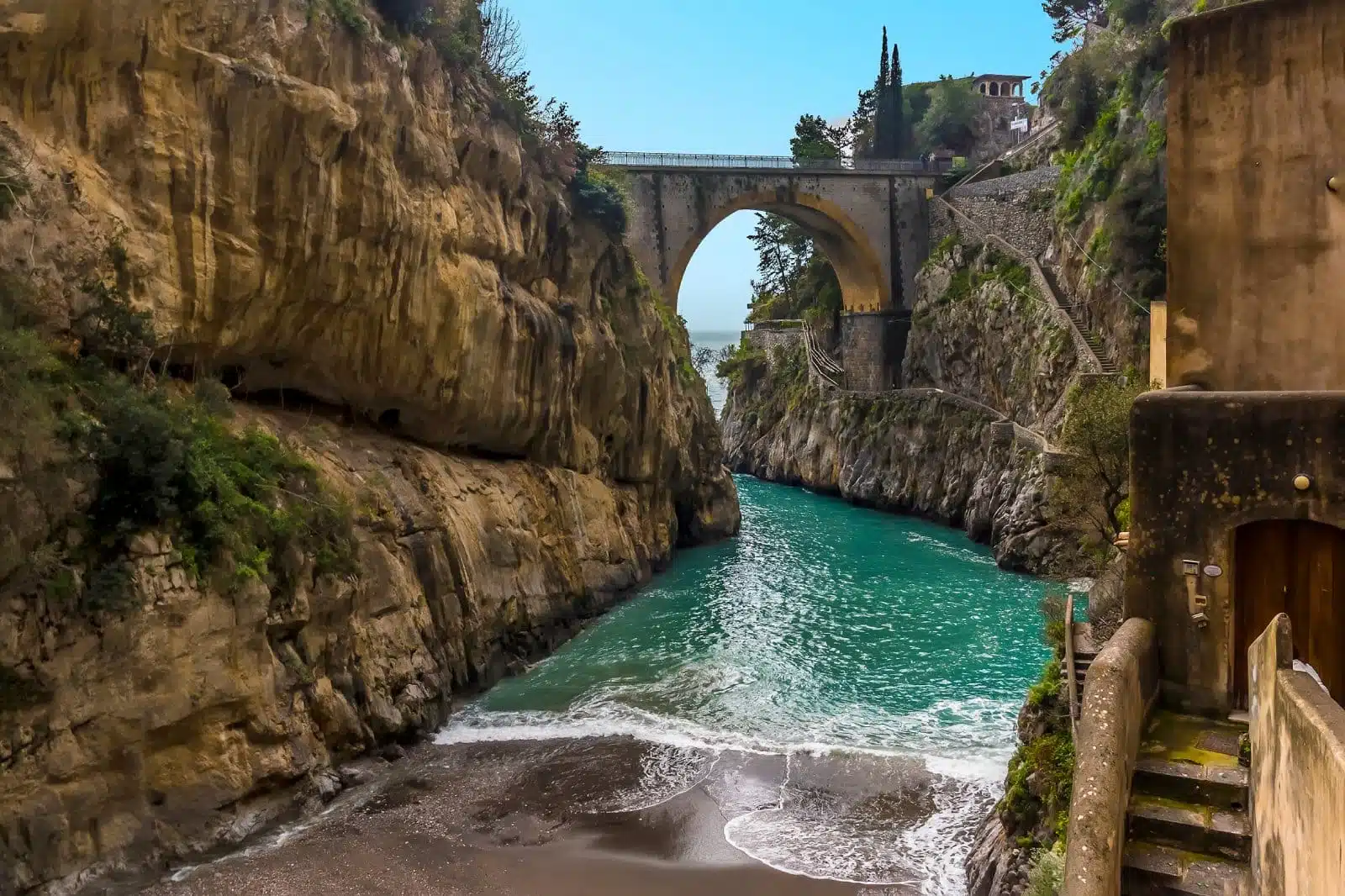
Image Credit: Shutterstock / Nicola Pulham
The Fiordo di Furore, a hidden sea inlet between towering cliffs, is one of the Amalfi Coast’s most enchanting and lesser-known spots. This natural fjord, created by the Schiato River carving through the rock, features a quaint beach and an ancient fishermen’s village that seems suspended in time. The bridge that spans the gorge offers a stunning vantage point for photographs, while the clear, turquoise waters invite a refreshing swim. The Fiordo di Furore is not just a natural wonder; it’s a slice of Amalfi’s history and culture, offering a peaceful retreat from the more crowded destinations along the coast.
Insider’s Tip: Visit during the annual high diving competition, when divers leap from the bridge into the fjord below, adding a thrilling spectacle to the beauty of the location.
When to Travel: The best time to visit the Fiordo di Furore is during the summer, from June to August, when the weather is warm, and the water is inviting.
How to Get There: The Fiordo di Furore is between Amalfi and Positano and can be reached by SITA bus or car. Parking is limited, so consider visiting early in the day or in the late afternoon.
9. The Emerald Grotto
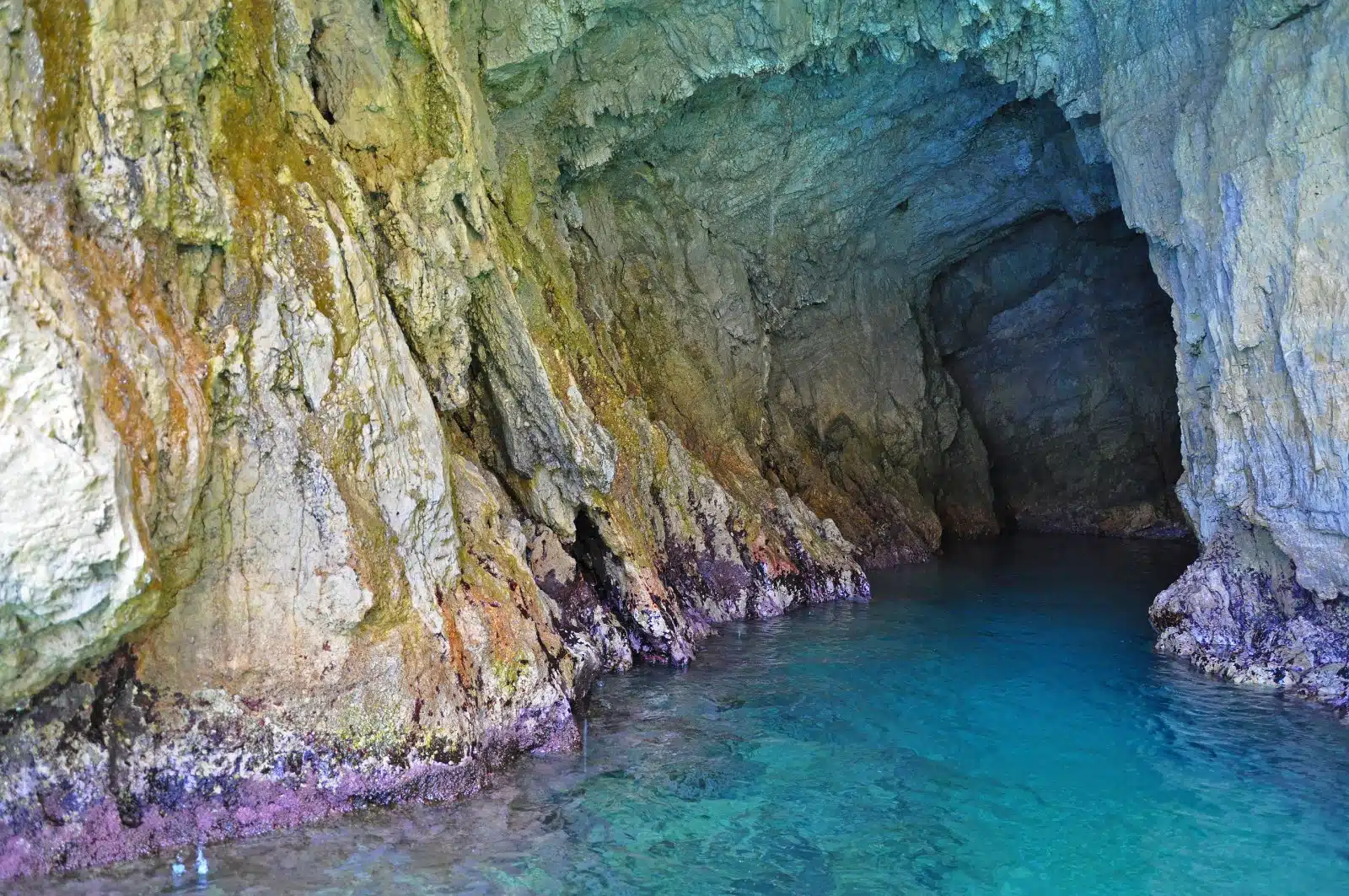
Image Credit: Shutterstock / stonja
The Emerald Grotto (Grotta dello Smeraldo), located near Amalfi, is a sea cave known for its ethereal green light that illuminates the interior, creating a surreal, otherworldly atmosphere. Discovered in 1932, the grotto is accessible by boat or via an elevator from the road above. Inside, visitors can take a boat tour around the cave, admiring the stalactites and stalagmites that adorn its walls, as well as the underwater nativity scene that adds a touch of local tradition to the natural beauty of the grotto.
Insider’s Tip: For a more serene experience, visit the grotto in the morning or late afternoon, avoiding the midday rush of tour groups.
When to Travel: The Emerald Grotto can be visited year-round, but the best time is from April to October when the sea conditions allow easy boat access.
How to Get There: The grotto is situated on the SS163 road between Amalfi and Positano. Boat tours depart from Amalfi and Positano, offering a scenic approach to the cave.
10. The Gardens of Villa Rufolo and Villa Cimbrone in Ravello
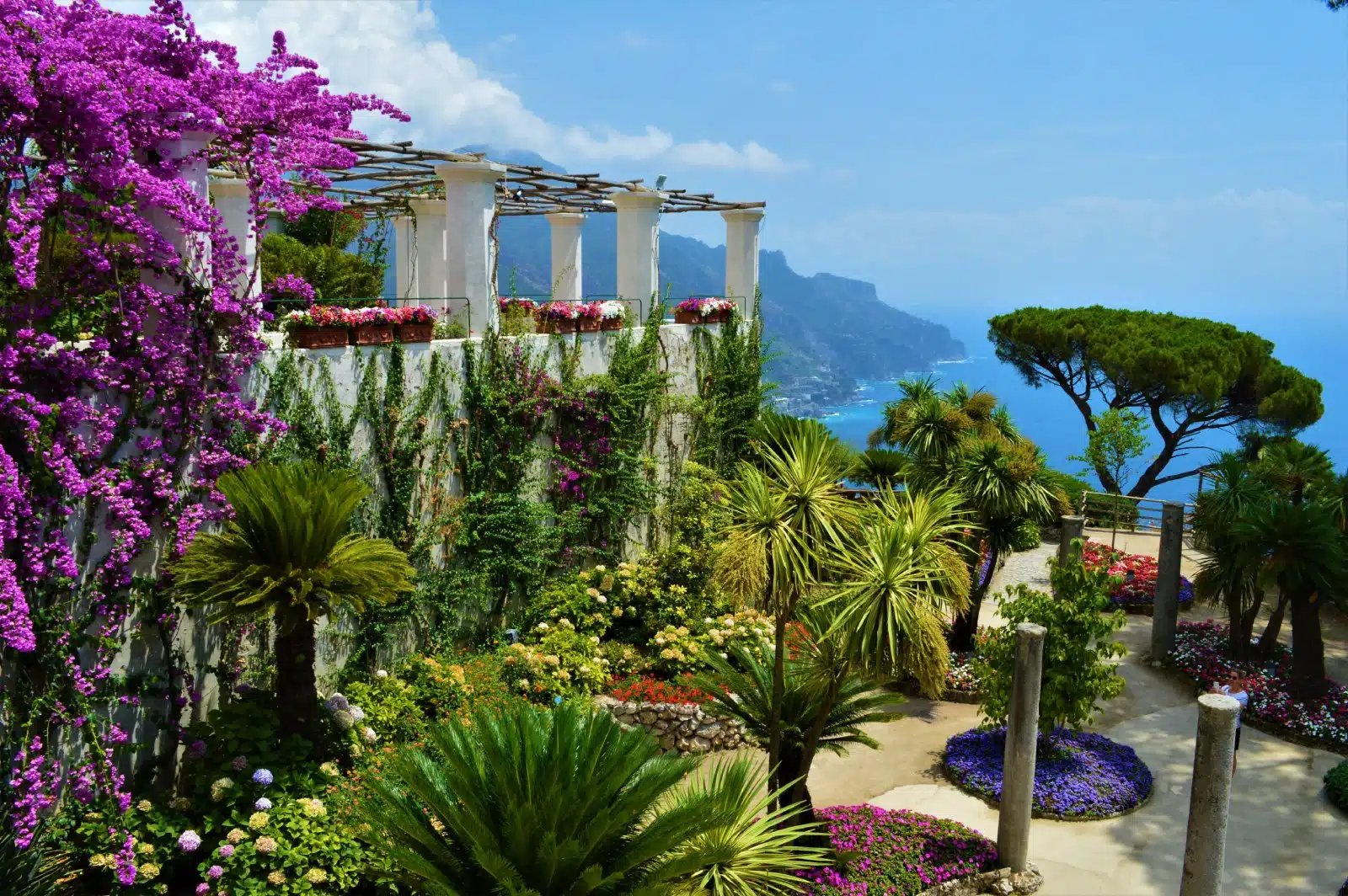
Image Credit: Shutterstock / Anna Dunlop
The gardens of Villa Rufolo and Villa Cimbrone, located in the hilltop town of Ravello, are among the most breathtaking on the Amalfi Coast. Villa Rufolo, with its mix of Arab, Norman, and Byzantine architecture, offers stunning views over the Gulf of Salerno from its terraced gardens. Villa Cimbrone, famous for its “Terrace of Infinity,” is surrounded by beautifully landscaped gardens that feature a mix of traditional Italian and English influences. Both gardens are a testament to the beauty of human creativity blended with natural splendor, offering tranquil spaces for reflection and admiration of the coast’s panoramic vistas.
Insider’s Tip: Visit Villa Cimbrone in the late afternoon to experience the golden hour on the Terrace of Infinity, where the setting sun casts a magical light over the sea.
When to Travel: The gardens are most vibrant from April to June, when the flowers are in bloom, though they offer beauty and tranquility throughout the year.
How to Get There: Ravello can be reached by SITA bus from Amalfi. Once in Ravello, both villas are within walking distance from the town center.
11. The Coastal Drive from Sorrento to Salerno

Image Credit: Shutterstock / Darius Boamah Photography
The coastal drive from Sorrento to Salerno is a journey through some of the Amalfi Coast’s most scenic landscapes. This winding route, known as the SS163, clings to the cliffs, providing dramatic views of the Mediterranean Sea, picturesque villages, and lush terraces. The drive itself, with its narrow roads and sharp turns, is an adventure, offering glimpses of hidden beaches, ancient watchtowers, and verdant valleys. Along the way, numerous spots exist to stop and soak in the views, making the journey as memorable as the destinations it connects to.
Insider’s Tip: Rent a small car or scooter for easier navigation of the narrow roads and tight parking spaces. Consider making the drive early in the morning or late in the afternoon to avoid the heaviest traffic.
When to Travel: The drive is spectacular year-round, but the best conditions are from April to June and September to October, avoiding the peak summer crowds.
How to Get There: The coastal road begins in Sorrento and ends in Salerno. Sorrento is accessible by train from Naples or by ferry from Naples, Capri, and other points along the coast.
12. The Isle of Capri
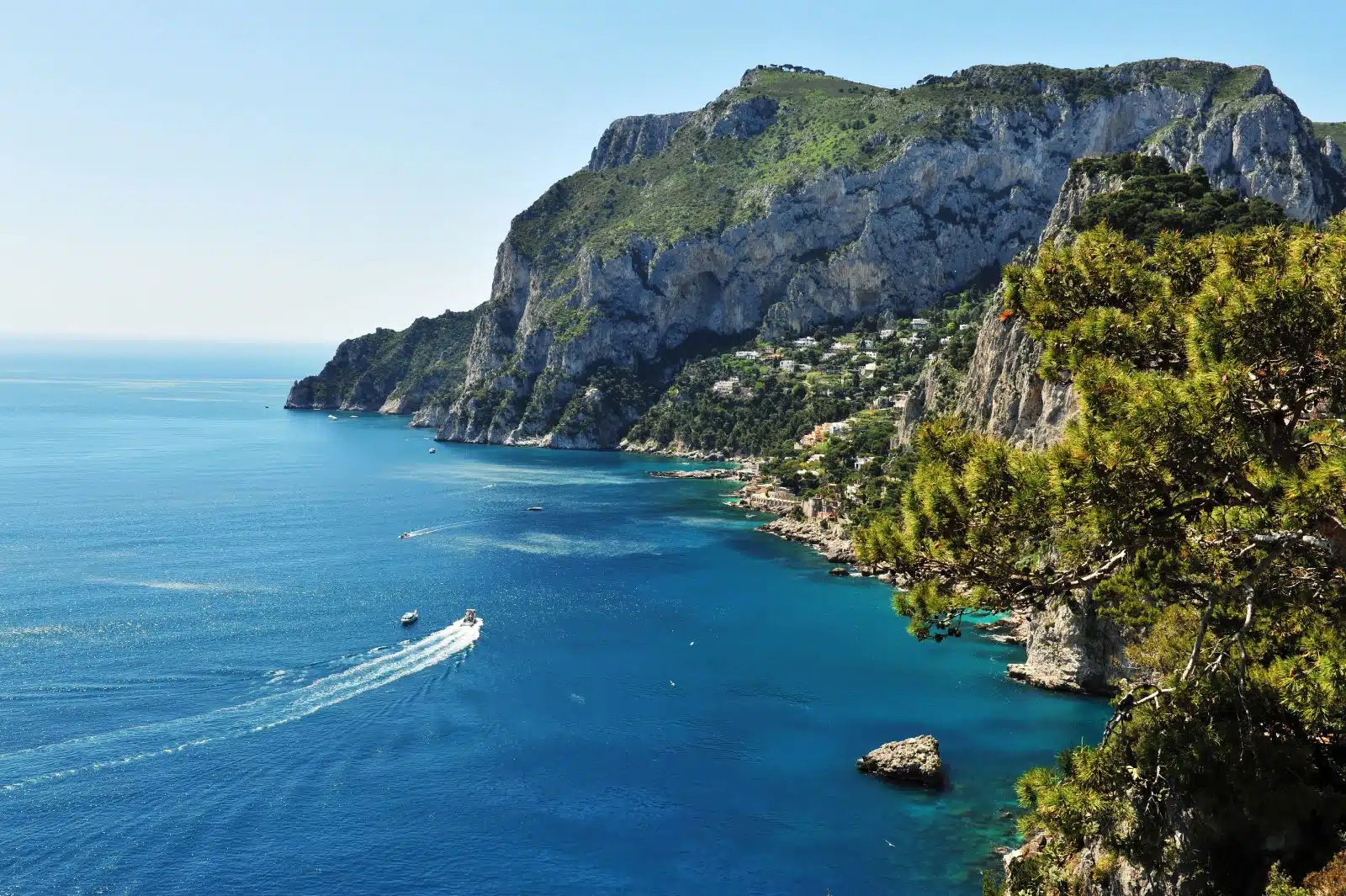
Image Credit: Shutterstock / Angelo Ferraris
The Isle of Capri, a short ferry ride from the Amalfi Coast, is a world-renowned luxury destination that has captivated visitors for centuries with its natural beauty and elegant charm. The island’s highlights include the Blue Grotto, a sea cave where sunlight turns the water a glowing blue; the scenic overlook at Monte Solaro; and the chic boutiques and cafes of Capri town. Capri’s combination of natural wonders, historical sites, and glamorous social scene makes it a must-visit for anyone exploring the Amalfi Coast.
Insider’s Tip: Take the chairlift to Monte Solaro for sweeping views of the island and the Bay of Naples, and visit the Blue Grotto early in the morning to avoid the crowds.
When to Travel: May and September offer the ideal balance of pleasant weather and fewer tourists, making it the perfect time to explore Capri’s beauty in relative tranquility.
How to Get There: Ferries to Capri depart from Sorrento, Positano, and Amalfi. Once on the island, public buses, taxis, and funiculars are available to navigate between attractions.
The Bottom Line
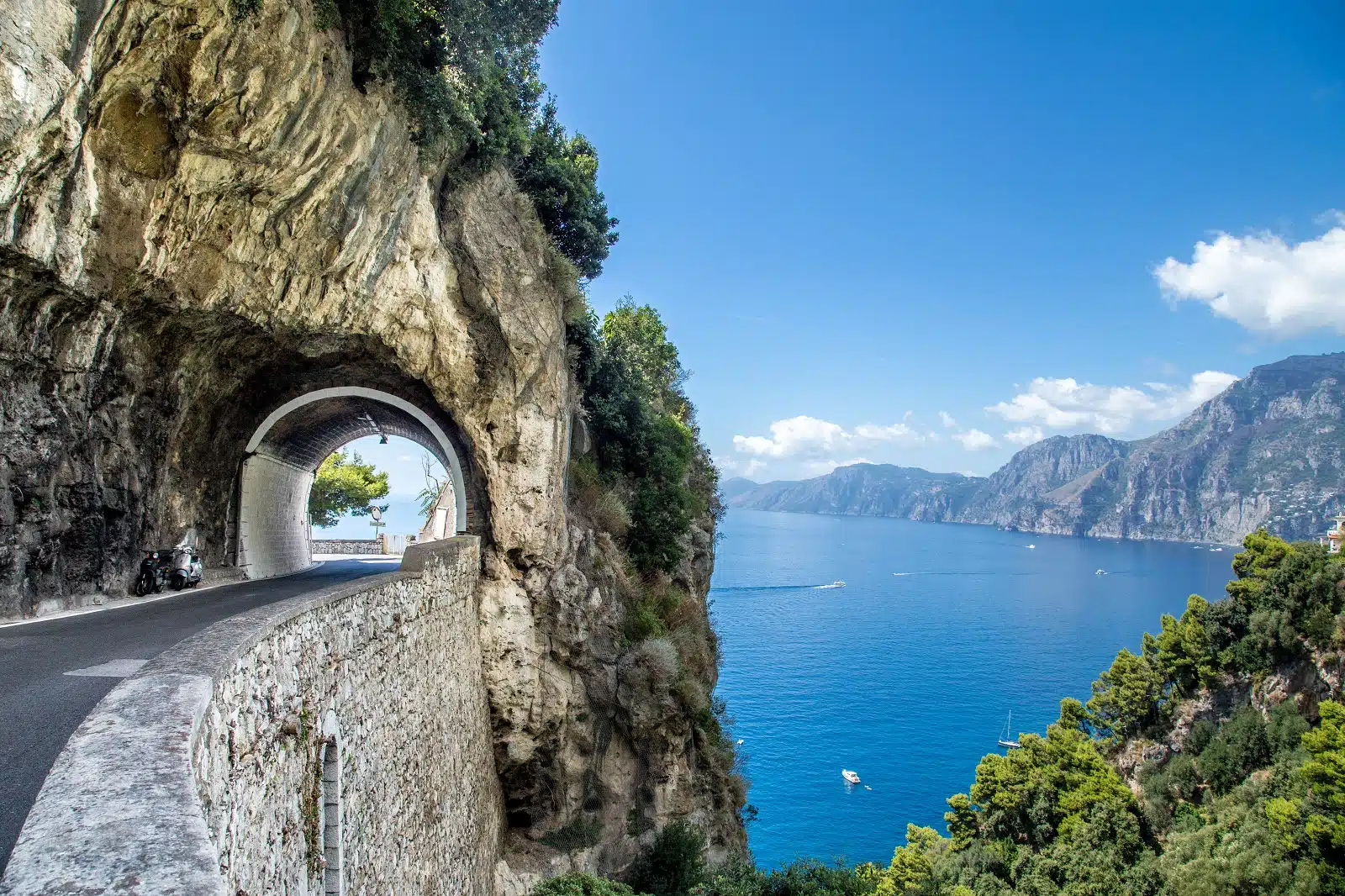
Image Credit: Shutterstock / Alexandree
The Amalfi Coastline, with its stunning landscapes, rich history, and vibrant culture, offers an unparalleled Italian Riviera experience. From the enchanting streets of Positano to the serene beauty of Ravello’s gardens and the timeless allure of Capri, this stretch of coast invites you to explore, relax, and immerse yourself in its many wonders. As you journey through these picturesque towns and breathtaking natural settings, remember to savor each moment, whether it’s a sunset over the sea, a leisurely meal of local specialties, or a quiet stroll through ancient streets.
More From The Green Voyage
Top 10 Trending Travel Destinations 2024
6 Essential Banking Apps for International Travel – Managing Your Finances on the Go
Traveling With Kids – 10 Tips to Create Memorable Family Holidays
The post The Amalfi Coastline, Italy 2024 first appeared on The Green Voyage.
Featured Image Credit: Shutterstock / Zigres.
For transparency, this content was partly developed with AI assistance and carefully curated by an experienced editor to be informative and ensure accuracy.
Tips for Trip Success
Book Your Flight
Find an inexpensive flight by using Kayak, a favorite of ours because it regularly returns less expensive flight options from a variety of airlines.
Book Your Hotel or Special Accommodation
We are big fans of Booking.com. We like their review system and photos. If we want to see more reviews and additional booking options, we go to Expedia.
You Need Travel Insurance!
Good travel insurance means having total peace of mind. Travel insurance protects you when your medical insurance often will not and better than what you get from your credit card. It will provide comprehensive coverage should you need medical treatment or return to the United States, compensation for trip interruption, baggage loss, and other situations.Find the Perfect Insurance Plan for Your Trip
